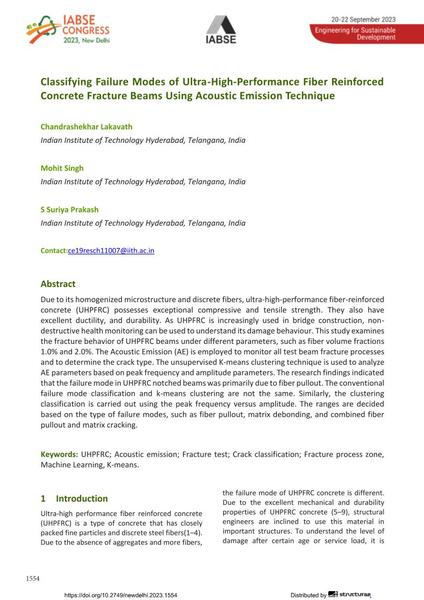Classifying Failure Modes of Ultra-High-Performance Fiber Reinforced Concrete Fracture Beams Using Acoustic Emission Technique

|
|
|||||||||||
Bibliografische Angaben
| Autor(en): |
Chandrashekhar Lakavath
(Indian Institute of Technology Hyderabad, Telangana, India)
Mohit Singh (Indian Institute of Technology Hyderabad, Telangana, India) S. Suriya Prakash (Indian Institute of Technology Hyderabad, Telangana, India) |
||||
|---|---|---|---|---|---|
| Medium: | Tagungsbeitrag | ||||
| Sprache(n): | Englisch | ||||
| Tagung: | IABSE Congress: Engineering for Sustainable Development, New Delhi, India, 20-22 September 2023 | ||||
| Veröffentlicht in: | IABSE Congress New Delhi 2023 | ||||
|
|||||
| Seite(n): | 1554-1560 | ||||
| Anzahl der Seiten (im PDF): | 7 | ||||
| DOI: | 10.2749/newdelhi.2023.1554 | ||||
| Abstrakt: |
Due to its homogenized microstructure and discrete fibers, ultra-high-performance fiber-reinforced concrete (UHPFRC) possesses exceptional compressive and tensile strength. They also have excellent ductility, and durability. As UHPFRC is increasingly used in bridge construction, non- destructive health monitoring can be used to understand its damage behaviour. This study examines the fracture behavior of UHPFRC beams under different parameters, such as fiber volume fractions 1.0% and 2.0%. The Acoustic Emission (AE) is employed to monitor all test beam fracture processes and to determine the crack type. The unsupervised K-means clustering technique is used to analyze AE parameters based on peak frequency and amplitude parameters. The research findings indicated that the failure mode in UHPFRC notched beams was primarily due to fiber pullout. The conventional failure mode classification and k-means clustering are not the same. Similarly, the clustering classification is carried out using the peak frequency versus amplitude. The ranges are decided based on the type of failure modes, such as fiber pullout, matrix debonding, and combined fiber pullout and matrix cracking. |
||||
| Stichwörter: |
Schallemission UHPFRC
|
||||
